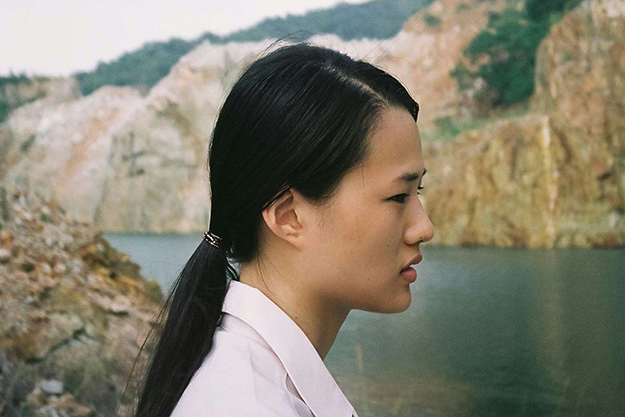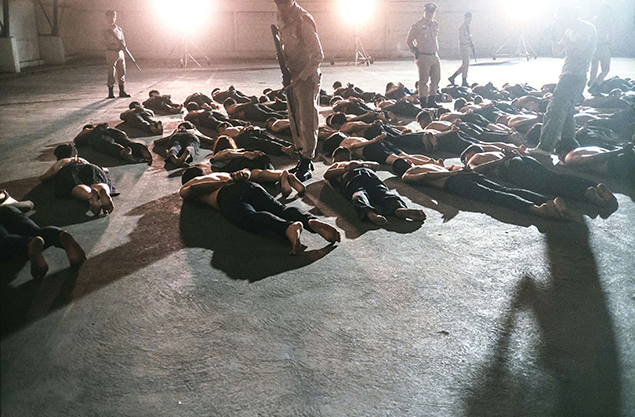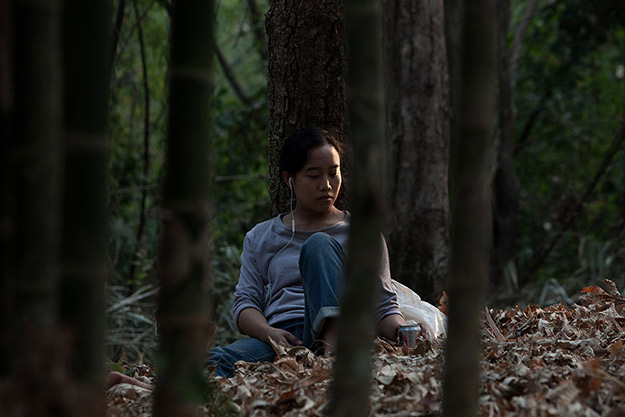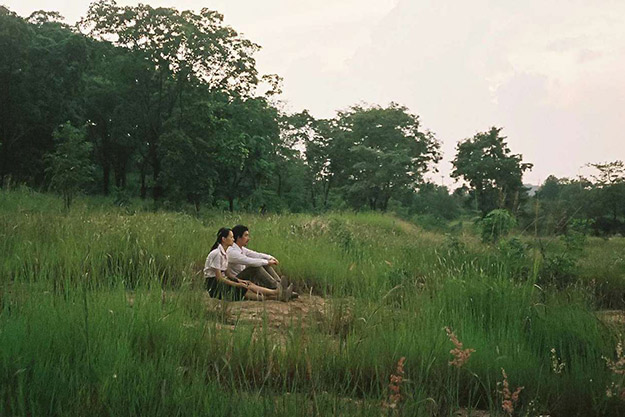Film of the Week: By the Time It Gets Dark

For its first 50 minutes or so, Anocha Suwichakornpong’s By the Time It Gets Dark seems relatively straightforward—relatively, that is. We seem to be dealing with an easily classifiable case of that rarefied subgenre, the film about filmmaking—specifically, a film about the difficulty of making fiction films about historical realities. A few minutes into the film, we see a large group of young people held at gunpoint on the floor of a warehouse by armed soldiers. We hear a woman’s voice: “Be more brutal!” she commands. “Kick them if you want!” Cut to black-and-white still shots of the prisoners, accompanied by the clicking of a camera. We see soldiers posturing as they stand guard over their victims: one, cigarette in mouth, strikes an insouciant pose, pointing his pistol askew in the way soldiers aren’t supposed to do but screen gangsters have been doing since Tarantino movies made it fashionable. Are we looking at a soldier who’s seen too many films, or an actor playing a soldier but stepping out of character between takes?
Either way, he isn’t acting as we might expect a Thai soldier to do in 1976—or in a film about the events of that year. The historical background to By the Time It Gets Dark is October 1976, when student protestors at Bangkok’s Thammasat University were massacred by Thai soldiers. That’s the subject of a film that, in the present day, a young female writer-director (Visra Vichit-Vadakan) named Ann—short for Anocha?—intends to make. As research, she’s interviewing a middle-aged writer named Taew (Rassami Paoluengton), a student activist four decades earlier. The two women have come to a spacious house in the country so that Ann can interview Taew about the horrors of ’76 as the basis for her script. Some of By the Time It Gets Dark simply covers the two women’s discussions at the house, sometimes with Taew reminiscing in long takes. Ann is clearly in awe of the older woman. “You’re living history,” she tells Taew. “Your life is meaningful… Whereas me, I appropriate someone else’s life and turn it into a film.” Whether modestly or with veiled contempt, Taew replies, “I’m not living history. I’m a survivor.” She asks Ann to sing to her, and the younger woman obliges with a song from her own childhood. For in her own way, Ann is living history too; we all are. It’s a highly pregnant moment that takes place during a power cut as the two women are watching television; they find themselves sitting by candlelight, gazing at themselves reflected on the TV screen (this is a film full of reflections on glass). It is a privileged parenthesis: a moment seemingly outside history yet situated in it via the echo of Ann’s childhood. Then suddenly the lights come on again, and we’re back into the flow of everyday time.
Described this way, By the Time It Gets Dark might sound like a simple story about the relationship between two generations of women, as they discover what’s common to, and different about, their experiences. But even before the film veers sharply into more confounding territory, it’s a little more complicated than that. Even in its first half, the film is spiked with flashbacks, digressions and other moments that make its narrative logic that bit more elusive. There are glimpses of ’76, as a young woman at a student meeting rages against the powers that be; she might be Taew’s younger self, but then she could be the younger Taew imagined by Ann for her film. There’s a bewildering scene that might be a dream, or a detour into magic realism: walking in the forest near the house, Ann spots a young girl, dressed in an animal costume. The pair walk on through the forest, casting wary looks at each other; then the editing makes it seem as if she is pursuing her own adult double. Other unexplained moments of disruption include a brief visual interlude in which the screen is suddenly filled with amber-colored reflections on what might be a camera lens; and a strange imagistic montage that takes in birds flying, an insect, speeded-up images of mushrooms growing and, out of nowhere, a mushroom-related clip from Méliès’s Journey to the Moon.

There are disorienting repetitions, too: notably, in the film’s second half, a reprise of Ann and Taew’s dialogue as they arrive at the house, only now with them both played by entirely different, markedly more glamorous actresses. This would seem to be a moment from Ann’s film—but why would she include this scene, unless she’s making a film as self-reflexive as Suwichakornpong’s own? In other words, is Ann making a movie about 1976, or a movie about making a movie about 1976? Take a pause for breath here: the hall of mirrors only gets deeper, denser with multiple reflections.
The big turn comes at around 50 minutes, when suddenly we seem to have slipped into a realistic drama set on a tobacco plantation; a handsome young man in a straw hat seems to be the owner or manager. But in reality—if that term has any stable application here—he’s a movie actor named Peter (Arak Amornsupasiri). We see him back at home in Bangkok, in a series of different settings—in one, shooting a music video (Amornsupasiri is himself a singer) for which studio assistants deck him out in a ridiculous papier-mâché fish costume. He’s also seen playing an airline pilot, looking cool at the wheel of a car (for real, or in a movie?), and naked in bed, languidly impassive with an admiring young woman (again, for real, or in a movie?).
Suwichakornpong is signaling the gap between cinema’s often glamorous artifice and the irreducibly brutal reality of modern Thai history, as experienced by Taew’s generation; she seems to be agonizing over what she sees as fiction’s inability to shake off an addiction to the superficial and do adequate justice to a troubled political past, which media fantasies help to keep buried, or at least to distract our attention from.

To that end, just as we’re consistently reminded that the reality glimpsed in this film is being artificially staged and recreated, so too the glossiness of modern Bangkok life is always undercut by the contingency of harsh reality. That’s never more true than when, in a studio session during the grading of what might be Ann’s film, news is announced that reminds us how death can suddenly disrupt the composed surfaces of the world of images.
Another character who drifts throughout the film, only incidentally related to the others, is a nameless woman (Atchara Suwan) who appears in various guises, associated with hands-on labor, as opposed to the artistic work that Ann seems so uneasy about. She’s first seen running a small café in the country; later, she appears as a cleaner at the luxury hotel where Peter takes a swim; then as a waitress on a pleasure boat, cleaning up leftovers and gazing out on Bangkok’s temples by moonlight; then, shaven-headed, as a Buddhist nun. And it’s around her, as she dances to blaring techno at a crowded club, that the film’s realistic textures finally collapse in on themselves, in a sort of visual implosion—a very routine effect of digital pixelation, but a stroke that puts the finishing touch to the film’s comprehensive self-deconstruction.
On one level, By the Time It Gets Dark rehearses a familiar inquiry into the ethical dilemmas involving the cinematic re-creation of reality, a consistent preoccupation of self-reflexive cinema. But the film’s textures and syntax are so strange and alluring that Suwichakornpong’s film becomes far more than the sum of its disparate parts. When the film screened in Locarno, comparisons were made with Apichatpong Weerasethakul—inevitable, no doubt, as most of us don’t have too many Thai cinema comparisons to draw on. To me, it doesn’t feel that much like an Apichatpong film—partly because of its distinctly female focus, the one significant male character here being something of a vacant shell contemplated by various women around him. Yet Suwichakornpong does undeniably have something in common with the older director, notably a taste for disorienting narrative and textural complexity that no doubt has something to do with the fact that they share an editor, Lee Chatametikool (joined on this film by Machima Ungsriwong). Suwichakornpong’s first feature Mundane History (2009) was a more straightforward drama, despite its play with non-chronological time: its story of a young paralyzed man and his carer shared with Apichatpong’s Syndromes and a Century and Cemetery of Splendor an interest in the different states of consciousness that might accompany physical or mental withdrawal from the everyday world. Mundane History also contained a dazzling image of galactic disruption—the birth of a supernova or something along those lines—that suddenly placed its intimate chamber drama within a vaster cosmological context.

By the Time It Gets Dark attempts something similar, but it’s a significant advance for Suwichakornpong; it’s more ambitious, more surprising, more formally supple. It’s also crammed with discreet but magnificent grace notes—like the abrupt sound cut from a supermarket cash register to the intense chirping of crickets in which much of the film is steeped. More than anything, Suwichakornpong’s film is Godardian—underneath its ostensibly calm surface, a film of abrasive ruptures that itself goes supernova at the end.
By the Time It Gets Dark opens exclusively at the Film Society of Lincoln Center on April 14.
Jonathan Romney is a contributing editor to Film Comment and writes its Film of the Week column. He is a member of the London Film Critics Circle.







